
DSM-5-TR Insanely Simplified
Unlocking the Spectrums within DSM-5-TR and ICD-10

PAYBACK Punkte
13 °P sammeln!
The publication of the Diagnostic and Statistical Manual Version 5 (DSM-5, 2013) and the more recent Diagnostic and Statistical Manual Version 5 - Text Revision edition (DSM-5-TR, 2022), together ushered in a major change to the field of mental health diagnosis. DSM-5-TR Insanely Simplified provides a summary of key concepts of the new diagnostic schema introduced in DSM-5 as well as the updated DSM-5-TR. It utilizes a variety of techniques to help clinicians master the new spectrum approach to diagnosis and its complex criteria. Cartoons, mnemonic devices, and summary tables allow clinicians ...
The publication of the Diagnostic and Statistical Manual Version 5 (DSM-5, 2013) and the more recent Diagnostic and Statistical Manual Version 5 - Text Revision edition (DSM-5-TR, 2022), together ushered in a major change to the field of mental health diagnosis. DSM-5-TR Insanely Simplified provides a summary of key concepts of the new diagnostic schema introduced in DSM-5 as well as the updated DSM-5-TR. It utilizes a variety of techniques to help clinicians master the new spectrum approach to diagnosis and its complex criteria. Cartoons, mnemonic devices, and summary tables allow clinicians and students to quickly grasp and retain broad concepts and subtle nuances related to psychiatric diagnosis. ¿DSM-5-TR Insanely Simplified fosters quick mastery of the most important concepts introduced in DSM-5 and continued in DSM-5-TR, while offering an entirely new way of looking at mental health along a continuum. This new approach goes beyond simply "labeling" clients with various diagnoses, but rather places them along spectrums that range from normal to problematic symptoms. Mental health professionals and laypeople will appreciate the synthesis of deep psychology and modern approaches to the diagnosis of mental illness. Table of Contents DSM-5-TR Summary Pages Section I: Overview 1. Introduction 2. History of the DSM 3. What is new in DSM-5-TR 4. What was new in DSM-5 5. The 8 Primary Psychiatric Spectrums of Mental Illness Section II: The 8 Primary Spectrums of Psychiatry 6. The Depression Spectrum: Shallowness vs. Despair 7. The Mania Spectrum: Boring vs. Bipolar 8. The Anxiety Spectrum: Carelessness vs. Anxiousness 9. The Psychosis Spectrum: Visionless vs. Psychotic 10. The Focus Spectrum: Attention Deficit Disorder vs. Obsessive Compulsive Disorders 11. The Substance Abuse Spectrum: Ascetic vs. Addicted 12. The Autism Spectrum: Codependent vs. Autistic 13. The Personality Spectrum: Neurotic vs. Obnoxious Section III: The Secondary Areas of Diagnosis 14. The Specialty Areas (Trauma, Neurodevelopmental, Neurocognitive, Behavioral, Dissociative, Somatic, Eating, Elimination, Sleep, Sexual, Gender, Paraphilia) Section IV: Conclusions 15. The Harmony of the Lotus Flower 16. Carl Jung and his Relationship to DSM-5-TR Appendix: On ICD-10 and the DSM-5-TR Endnotes Index












